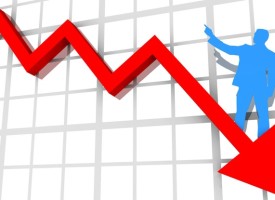Gerald Celente just issued this shocking new forecast about America.
Can’t Afford The “American Dream?”
January 12 (King World News) – Gerald Celente: A $100,000 annual household income, thought not long ago to be a ticket to the upper middle class, can no longer guarantee the “American Dream” of a single-family home in the suburbs, two cars in the garage, a child or two, and a college fund for the kids, according to a recent analysis by Business Insider (BI).
The median price of a U.S. home was $7,354 in 1950 and $11,900 in 1960, according to census bureau data cited. When adjusted for inflation, those prices would rise to $85,000 and $111,000 in 2021 dollars, respectively.
However, the median selling price of an American single-family home in 2021’s third quarter was $404,700, according to data compiled by the Federal Reserve Bank of St. Louis.
During that quarter, the cost of housing rose 18.6 percent, year over year.
Millennials now buying their first homes are paying 39 percent more for a house than families buying homes in the 1980s, according to an earlier BI study.
Can They Afford It?
In October 2019, 852,090 homes for sale were affordable for a household with a $100,000 income. In October 2021, the number had dropped to 348,800, according to BI.
“That means more than half the houses affordable to a $100,000 earner are off the market,” BI noted.
In “Home Prices Up, Incomes Down” (16 Nov 2021), we reported that, since 1971, after factoring in inflation, the price of the average home is up 118 percent, but incomes have gained a meager 15 percent, a separate report by online brokerage Clever Real Estate found after studying census bureau data.
The cost of housing should take no more than 30 percent of gross income, economists and financial advisors often say.
Using that guideline, to afford a median-priced U.S. home now, a household would need an income of $144,192, more than double the median household income of $69,178, Clever calculated.
While some advisors say a home’s purchase price should not exceed 2.5 times a household’s annual income, in today’s frantic market a house now sells for an average of 5.4 times more than a typical buyer’s gross income, according to Bloomberg…
Keith Neumeyer Just Predicted $100+ Silver And $3,000 Gold! TO LISTEN CLICK HERE OR ON THE IMAGE BELOW.
The New Normal: Renting
As a result, “In 2019, about 19 percent of U.S. households with six-figure incomes rented their homes, up from about 12 percent in 2006,” The Wall Street Journal reported in an October 19, 2019, article after analyzing census bureau data adjusted for inflation.
“The increase equates to about 3.4 million new renters who would have likely been homeowners a generation ago,” the WSJ concluded.
As we have documented in articles such as “Rents Soaring. What’s Next?” (21 Sep 2021), the growing number of households forced to rent instead of buy has pushed rents to record levels as more and more people locked out of the mortgage market still want to live in a detached suburban house with a yard.
Rents rose at an annual clip of 13 percent from January through June 2021, with rate increases breezing past 20 percent in hot areas such as Boise, Id. and Naples, Fla.
As rents climb along with house prices, even fewer households will be able to set aside enough cash for a down payment to buy.
Those increases pinch especially for households with children.
The cost to a middle-class family to raise a child from birth through age 18 is now $267,233, or $14,846 annually, about $1,237 a month, according to a September article by U.S. News & World Report.
Working parents often must add in the cost of child care, which averages $1,075 monthly across the U.S., ranging from $453 in low-income Mississippi to $1,743 in pricey Massachusetts.
However, even before factoring the cost of a child or two, many earners already are squeezed by their load of student debt.
Debt
Last November, about 42.9 million Americans each owed an average of $37,105 on federal student loans, a number that does not include loans taken out by parents or from other private sources to foot the bill for tuition, books, room, and board, according to federal data gathered by the private Education Data Initiative.
That, in part, is because the cost of a four-year undergraduate degree at a public college or university has more than doubled from $10,760 in the 1991-1992 school year to $22,690 for the current academic year.
For a private school, the cost including room and board averaged $28,000 30 years ago; now it has soared to $51,690, College Board figures show.
The “advantage of a degree today is less than it was 10 years ago, because of the rising cost,” Richard Vedder, an Ohio University economics professor emeritus, told BI. “The return on investment has fallen.”
Even highly educated six-figure earners can struggle to make ends meet.
More Than 1/3 Of His Take-Home Pay
A tech professional cited by Business Insider was earning more than $120,000 with a San Francisco-area company and paying more than $2,500 a month on his student loans, which, after taxes, was more than a third of his take-home pay.
In a September 2021 Parents magazine article, Irina Gonzalez wrote that she and her husband gross almost $150,000 annually, but are “broke” because of the costs of child care and repaying student loans.
“This is the current state of the American Dream for so many Millennial parents,” Gonzalez said—“stuck between a rock and a hard place as we deal with our own debt and rising childcare costs while living paycheck to paycheck.”
Everything Is Getting More Expensive
And the car that rounds out the American Dream now sells for an average price of $46,036, up $5,266 from a year earlier, according to October figures from Kelly Blue Book—more than double the $21,850 that buyers paid for new rides in 2000. (J.D. Power pegged the average sales price at $45,703 in December.)
No wonder that the typical convenience store customer drives a 12-year-old car worth about $15,000, a study by convenience chain owner Murphy USA found, as we reported in “Gas Station Owners Skeptical of EV Boom” (17 Aug 2021).
Home prices have risen 300 percent in real terms since 1960, the cost of a car has risen more than 100 percent in the past 20 years, and college costs are at least 100 percent higher than 30 years ago; so what has happened to incomes?
According to October 2021 figures from the U.S. census bureau:
- Since 1967, the middle-earning 20 percent of the population has seen its income increase by 41.1 percent, an increase of barely 0.75 percent in each of the last 54 years.
- The bottom-earning 20 percent has gained 34.2 percent in income over the last 54 years;
- The highest-grossing 20 percent of U.S. workers has gained 109.3 percent in income, more than double its salary in 1967;
- The top 5 percent of earners have enjoyed an additional 133.5 percent in income since 1967.
Not even the 5 percent of the population earning the highest incomes have been able, as a group, to keep pace with the rising cost of housing, vehicles, or education, census bureau figures show.
TRENDPOST:
The census bureau numbers show that the old saying is true: the rich do get richer—but only the top 0.1 percent of earners make enough to keep pace with rising costs, even before the COVID War tangled supply lines and caused shortages in a time of heightened demand.
According to the U.S. Bureau of Economic Analysis, real incomes in the U.S. shrank by 0.3 percent last year, while personal expenses rose 0.7 percent. While inflation added almost 8 percent to price tags last year through November, the average worker’s pay increase of 3 percent was less than half of what was needed to keep pace, a Brookings Institution analysis found.
TREND FORECAST:
As we have noted several times previously, once prices inflate, they virtually never return to their previous low levels. (Petroleum fuels are an obvious exception.)
An element of the “Off-With-Their Heads 2.0” movement will be, as rising prices continue to leave households able to afford less and less, pressures will rise—especially among younger Americans—for socialist movements… to socialize the costs of child care, health insurance, post-secondary training, and other essentials increasingly affordable only by the upper of the upper-class.
To listen to James Turk discuss why gold may finally be poised for a major up-move in 2022 CLICK HERE OR ON THE IMAGE BELOW.
To hear Alsadair Macleod discuss why big money is suddenly buying dips in the gold market CLICK HERE OR ON THE IMAGE BELOW.
© 2022 by King World News®. All Rights Reserved. This material may not be published, broadcast, rewritten, or redistributed. However, linking directly to the articles is permitted and encouraged.










